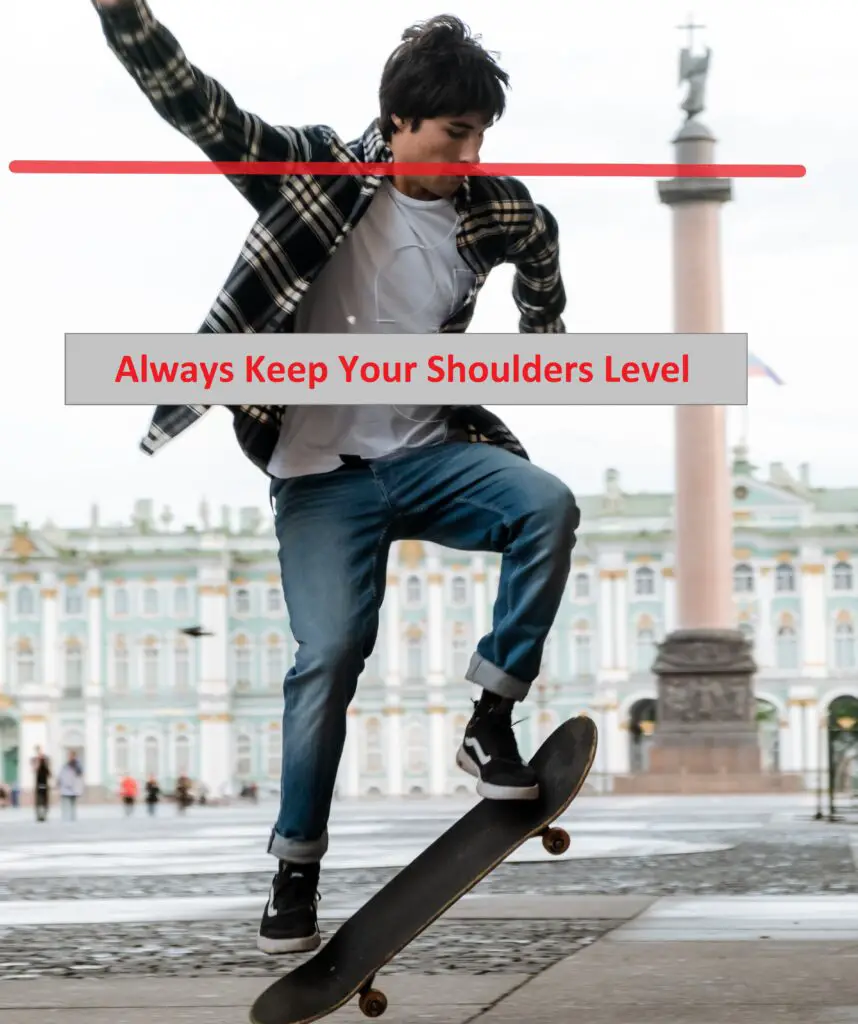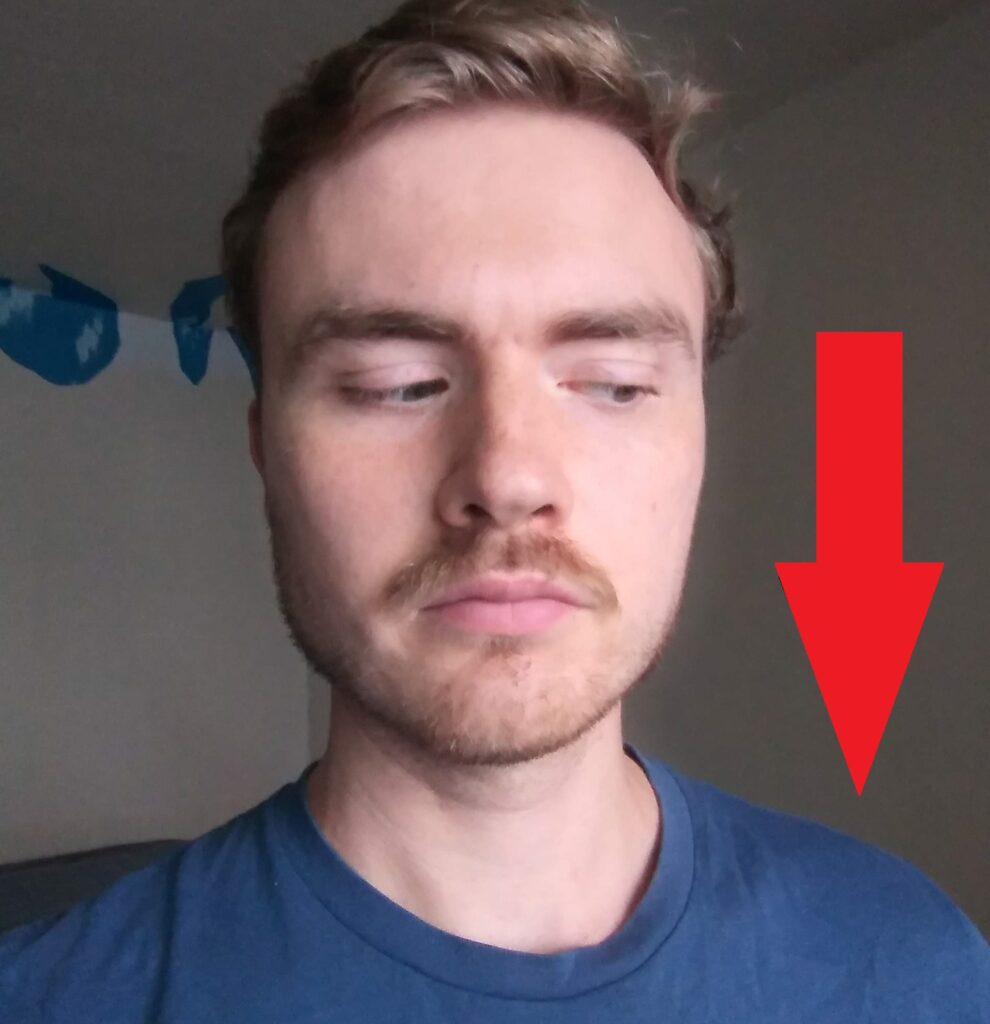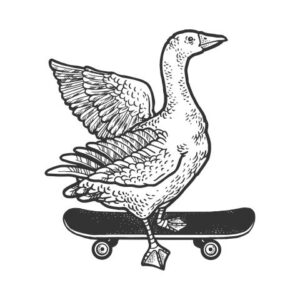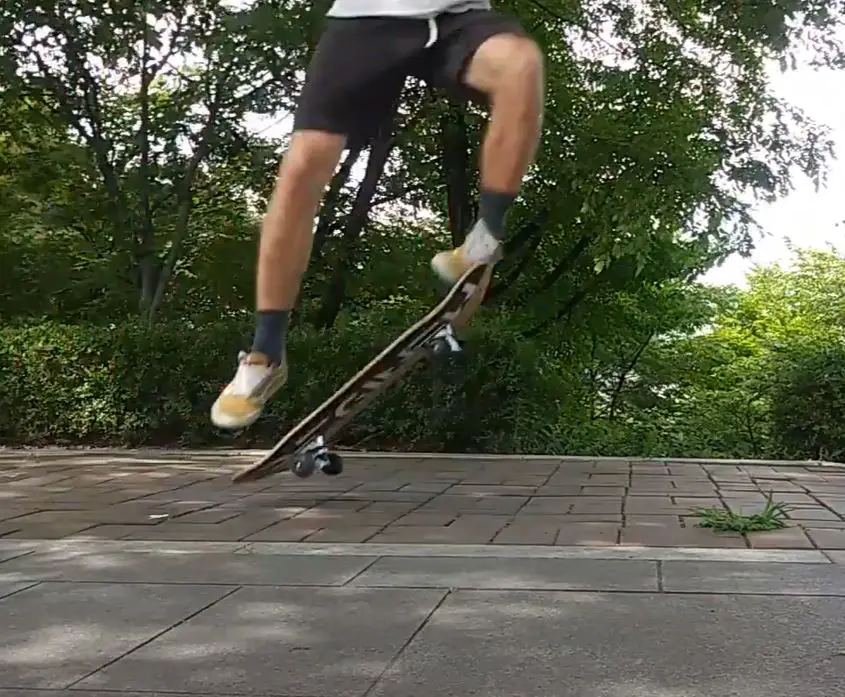This is probably the number one problem for people trying to learn to ollie. Maybe you learned an ollie without moving, but whenever you start moving you turn and fall off your board.
Keep in mind that this problem is something that will come up again and again with all of your tricks and the root cause is the same. You aren’t controlling your board with your shoulders.
This might sound weird, but upper body and shoulder control is board control. Having a centered upper body with both shoulders parallel to the ground is key to controlling your board. I will say this again. Your shoulders determine where your board is going to go. Your legs will follow.
Why Do I Turn When I Ollie?
Everyone does this from time to time. Even experienced skaters.
The skateboard will turn while doing an ollie because of the shoulders turning. You may turn your shoulders a full 90-degrees or just a bit, but the board follows wherever your shoulders go. Instinctively, your body wants to face whatever it perceives as dangerous, so you turn to face the direction you’re moving in. You’re unconsciously anticipating a fall.
The gist is that aren’t consciously controlling your upper body, as you’re probably focused on your foot sliding, and you’re turning without realizing it. On some level, you’re preparing to fall and catch yourself. If you don’t consciously control your upper body and shoulders, then your mind will naturally move it for you.
How to Ollie Straight
The first step to being able to ollie straight is being able to ollie. Can you slide your foot and catch your board? Does your board come up and off from the ground?
If no, then stop, and focus on sliding your foot on a stationary pop. Practice popping the back of the board up so you even have a chance to catch it with your front foot.
If yes, now you can learn to ollie straight.
To ollie straight, focus on your shoulders. Your shoulders should remain level and parallel to the surface you’re skating. If the surface is flat, keep your shoulders flat. Try and pop the board for a normal ollie and focus on keeping your shoulders completely still. You might want to naturally turn, but consciously force yourself to stay still.
If you watch the best skaters, you can notice that their upper body barely moves at all. Even when they do something that requires a shift of the shoulders like a manual or rotation trick, the shoulders move positions and lock in steady once again.
If you can learn to control your shoulders, your skating will improve so much. It will help not only for ollies but also for all the tricks that you will learn later. If you want to skate cleanly, then you need to be conscious of how your shoulders are moving.

If you are interested in how long it takes to learn an ollie on average, check out our data-driven guide here.
Tips To Not Turn While Doing an Ollie
Start Off Slow
The main underlying reason that you turn when you ollie is that you are anticipating a fall. The faster you are going the more real and intimidating this fear can be. So to start off learning to ollie while moving, go slow.
Make sure you have enough speed that a crack won’t stop you, but going too fast early on will make things more difficult than they need to be. Even now, if I’m skating down a hill or otherwise just going very fast, sometimes I turn my body and bail out of the ollie. It’s instinctive.
You need to build up to that speed. You don’t start running and instantly go for a marathon so why do you need to be going 30 miles per hour to do an ollie?
Focus on Your Front Shoulder
It can be hard to focus on everything at once. Even now, sometimes being aware of both of my shoulders and if they are turning when I want them to and if they are parallel to the ground is hard to do.
An easy thing to focus on is your front shoulder only. This can simplify what you need to control as you can just make sure the front shoulder points in the direction that you’re moving.
This can get you into trouble though if you’re not skating on a perfectly flat surface. On a slanted surface, you need to be aware of both shoulders and keeping them level as well as not turning them. This sounds hard, and it is.

Skate On a Flat Surface
This tip goes back to the previous one slightly. When you skate on any surface, both of your shoulders need to stay parallel to the surface. This is much easy to do if the surface is flat.
In fact, if the surface is flat then you really don’t need to think too much about this for an ollie. For most people, this comes somewhat naturally and you can tell if it doesn’t. If your shoulders aren’t parallel with the surface, then you lean back and won’t catch the board or you will slam down your ollie super quickly with no air time.
I won’t go over these other common problems here, but I have written and explained a good list of issues in a previous article.
If you want to see a complete list of common problems that happen when learning to ollie, check out our guide here.
Be Patient
Most people seem to think that an ollie is the simplest trick and they should learn it in one afternoon. This simply isn’t the case.
An ollie is a complex set of motions that involves coordinated motion of your entire body. It is actually very difficult and it typically takes months to get a decent ollie consistent. Then it will take longer to get a good feel and control over your ollie.
So be patient. You’re in it for the long haul. There’s still plenty of small celebrations to be had along the way.
The Secret is in the Shoulders
I know I’ve said this at least ten times at this point, but it is so stupidly universally true that it stands to say again. Focus on controlling your shoulders. Shoulder control is board control.
In my experience learning an ollie and other tricks, learning the basic foot motion is relatively simple to do. My problems with landing the trick and being consistent always (ALWAYS) come down to my shoulders turning or not staying parallel as they should.
It’s true that I’m just one skater and maybe you struggle with the feet motions, but the shoulders come up again and again. Go watch some elite skaters hit some spots on YouTube. Notice how little their upper body moves unless they are purposely rotating or hitting banks and ramps.
How to Fix an Ollie
Often, when you’re learning a new trick it feels like you sort of “get it” by the end of one session only to go back to the beginning for the next session.
The process of learning a trick is kind of like circling a drain. Some days you will have it and some days it will seem like you can’t land the ollie or whatever trick you’re trying to learn.
At this point, you will need to know all of the parts of the ollie which are as follows:
- Pop back tail
- Slide up front foot
- Keep shoulders level
- Don’t turn shoulders
- Land with slightly more weight on your back foot
These are the general parts of the ollie. You will likely be messing up one or more parts of this and to “fix” your ollie you need to diagnose what part is being messed up. Then you need to consciously be aware of that “part” of the ollie and try and correct the motion.
This is so hard as a beginner. It often seems impossible to tell what you are doing wrong. My suggestion is to video yourself doing your ollie and from a third-person perspective, you should be able to figure it out.
Conclusion
So that’s the gist of learning to ollie straight. To summarize, the problem is your shoulders. Stop turning your shoulders and keep your shoulders parallel to the surface you’re skating. If you’re skating flat ground, this means keep your shoulders flat.
I hope this helped and if you need more assistance I have a couple more articles about learning to ollie here:
- Ollie While Moving- Common Problems and Solutions
- How Long Does It Take to Learn an Ollie?- With Data
Anyway, thanks for reading, and look out for more articles from Board and Wheels.


